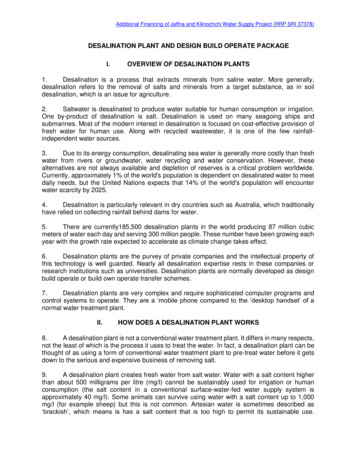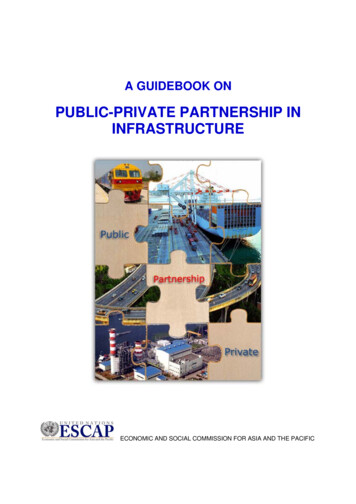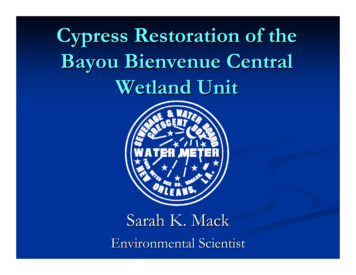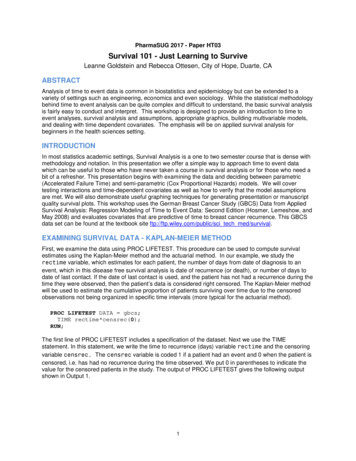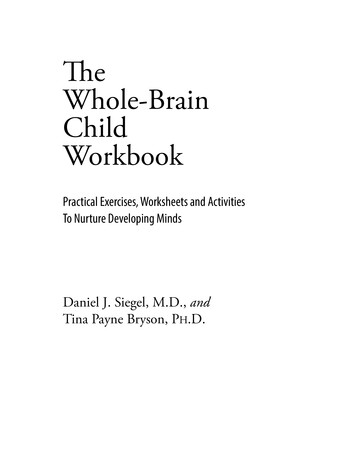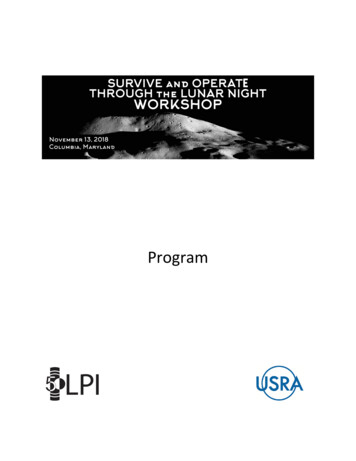
Transcription
Program
Survive and Operate Throughthe Lunar Night WorkshopNovember 13, 2018 Columbia, MarylandInstitutional SupportNASA Solar System Exploration Research Virtual InstituteNASA Lunar Exploration Analysis GroupLunar and Planetary InstituteUniversities Space Research AssociationNational Aeronautics and Space AdministrationConvenersRenee WeberNASA Marshall Space flight CenterAndrew PetroNASA HeadquartersOrganizing CommitteeBradley BaileyNASA Ames Research Center/Solar System Exploration Virtual InstituteD. Benjamin J. BusseyNASA HeadquartersGregory ChaversNASA Marshall Space Flight CenterDavid KorsmeyerNASA Ames Research CenterSamuel LawrenceNASA Johnson Space CenterSarah NobleNASA HeadquartersAndrew PetroNASA HeadquartersGreg SchmidtNASA Ames Research Center/Solar System Exploration Virtual InstituteRenee WeberNASA Marshall Space Flight CenterAlison ZunigaNASA Ames Research CenterLunar and Planetary Institute 3600 Bay Area Boulevard Houston TX 77058-1113
Abstracts for this workshop are available via the workshop website t2018/Abstracts can be cited asAuthor A. B. and Author C. D. (2018) Title of abstract. In Survive and Operate Through the Lunar Night,Abstract #XXXX. LPI Contribution No. 2106, Lunar and Planetary Institute, Houston.
Survive and Operate Through the Lunar Night WorkshopTuesday, November 13, 2018USRA Headquarters, Columbia, MDAgendaTimeSpeakersWelcome and Workshop Objectives8:30–8:40 a.m.Overview of Lunar Day/Night Environmental Conditions —Including Various Latitudes, Polar Regions, PermanentlyShadowed Regions, Peaks of Eternal LightLessons Learned from Missions that Have Survived LunarNight (Surveyor, ALSEP, Lunokhod)Panel Discussion: Evolving Requirements from Survival toContinuous Operations for Science, Exploration, andCommercial Activities8:40–9:00 a.m.Andrew Petro, NASA HQRenee Weber, NASA MSFCBrett Denevi, JHU APL9:00–9:20 a.m.Ron Creel, NASA Retired9:20–10:20 a.m.Science PerspectiveSam Lawrence, NASA JSC:SAT BriefingBREAK10:40–11:40 a.m.LUNCHPanel Discussions:Technology GapsPanel 1:State of the Art, Potential Solutions, and11:40 a.m.–1:00 p.m.1:00–2:00 p.m.Power Generation, Storage, and DistributionPanel 2: Thermal Management Systems, Strategies, andComponent Design FeaturesBREAK2:15–3:15 p.m.Co-Chairs:ASM/NEXT-Exploration PerspectiveBen Bussey, NASA HQPanelGreg Chavers, NASA MSFC/HQDave Blewett, JHU APLDana Hurley, JHU APLJames Carpenter, ESAOn your ownPower PanelModerator: Lee Mason, NASA STMDLen Dudzinski, NASA HQ: RPS and FissionBob Sievers, Teledyne: Fuel Cells, RTGsErik Brandon, JPL: BatteriesPaul Alburtus, ARPA-e: Energy StorageCommercial Space Panel: Understanding the EconomicBusiness Case for Creating Lunar Infrastructure Services andLunar Markets3:15–4:00 p.m.International Space University Summer Project Presentation“Lunar Night Survival”4:00–4:20 p.m.Thermal Management PanelModerator: Rubik Sheth, NASA JSCEric Sunada, JPL: Robotic MissionsChad Bower, Paragon: CommercialSystemsKust Sacksteder, NASA GRC: ThermalWadiModerator: Alison Zuniga, NASA ARCGeorge Sowers, Colorado School of MinesDennis Poulos, Poulos Air and Space, Inc.Dennis Wingo, SkyCorp Inc.Mahamed Ragab, iSpace Technologies, Inc.Rolf Erdmann, PT ScientistsMatt Henderson and Ilaria Cinelli, ISUOpen Discussion and Conclusions4:20–5:30 p.m.Co-Chairs, All Workshop ParticipantsPoster Session Wednesday Evening, November 145:00–7:00 p.m.Posters Presented on Wednesday EveningDuring the 2019 LEAG Meeting
Wednesday, November 14, 2018POSTER SESSION: SURVIVE AND OPERATE THROUGH THE LUNAR NIGHT WORKSHOP5:00–7:00 p.m.USRA Education GalleryEvans M. E.AuthorsTitle and SummaryIgnatiev A.Lunar Superconducting Magnetic Energy Storage (LSMES) [#7001]This study seeks a method to efficiently store electrical energy without using chemicalbatteries, by applying terrestrial technology based on a superconducting coil and apersistent magnetic field located in a lunar permanently shadowed crater.Passive Survivability of 18650 Lithium-Ion Cells Through Lunar NightEnvironment Scenario [#7002]Present study describes passive survivability of commercially-off-the-shelf 18650lithium-ion cells tested in an environmental scenario similar to onset and progress oflunar night that is at cryogenic temperatures under vacuum for 336 earth hours.Data Encoded Laser Wireless Power (DELWP) for Lunar Polar Applications [#7003]Data encoded high power fiber lasers illuminating specialized tuned photovoltaicpanels designed for power transfer will provide reliable, continuous power and dataduring periods of limited solar illumination, including into the dark polar craters.Darkness Visible: Instrumentation and Thermal Design to Access theHidden Moon [#7005]We show mission concepts for a long-lived geophysical network and in-situinvestigation of volatiles in the lunar polar cold traps, and Ball instrument and thermaltechnology enabling survival, situational awareness, and operations in the dark Moon.Small Modular Fission Reactors that Enable Affordable and SustainableLunar Enterprise [#7006]We will present the results of a study looking at the use of a LEU-based Small ModularFission Reactor (SMFR) in the 40 to 100 kW range for lunar activities, building on theresults of NASA’s HEU-based KiloPower project.Multi-Lunar Day Polar Missions with a Solar-Only Rover [#7007]The lunar poles offer opportunities for solar-only rovers to survive and operate manylunar days. Presented here are examples of rover traverses that take advantage of theunique polar illumination environments to operate across multiple lunar days.Lighting Constraints to Lunar Surface Operations [#7008]An investigation into lunar surface ambient lighting levels indicates that, for mostnearside locations, illumination will be adequate throughout a large portion of thelunar night to conduct surface activities.High Performance Thermal Switch for Lunar Night Survival [#7009]A high performance differential thermal expansion (DTE) thermal switch wasdeveloped to enable solar/battery powered lunar surface science payloads. Themeasured thermal switch performance is: 5 W/K ON, 0.002 W/K OFF, and 2500:1ON/OFF ratio.Shifting the Paradigm of Coping with Nyx on the Moon — a Ground-PenetratingRadar Case [#7012]A multi-static, autonomous ground-penetrating radar instrument, MARGE, willincorporate strategies to be more tolerant of the lunar diurnal thermal cycle.Requirement Analysis and Night Survival Concept for Z-01 Landing Mission UsingFuel Cell [#7014]Only three missions have survived the lunar night, using Radioisotope Thermo-ElectricGenerators and Radioisotope Heating Units. This paper discusses the challenges tosurvive lunar night and presents a fuel cell-based concept as an alternative.Lunar Roads: Strategies for Remaining in the Sunlight [#7017]By driving westward on the slowly rotating Moon, telerobots could remain in thesunlight while compressing the regolith in order to make basic, reduce-dust roads.Nandini K.Usha K.Srinivasan M. S.Pramod M.Satyanarayana P.Sankaran M.Poulos D. D.Van Cleve J. E.Weinberg J. D.Neal C. R.Elphic R. C.Weed K.Mills G.Dissly R.Herring J. S.Mackwell S.Pestak C.Colaprete A.Siegler M.Elphic R. C.Shirley M.Eppler D. B.Budden N. A.Bugby D. C.Clark P. E.Hofmann D. C.Nunes D. C.Haynes M.Carpenter K.de la Croix J. P.Wani S. C.Shah U. B.Kothandhapani A.Garg P.Sahai M.Garg M.Nair S.Plata D. S.
AuthorsPowell T. M.Molaro J. L.Title and SummarySiegler M. A.Paige D. A.Dillon R. P.Borgonia J-P. C.Roberts S. N.Hofmann D. C.Kennett A.Firdosy S. A.Wilcox B. H.Hales S.Smith J. D.Schuler J.McEnerney B.Shapiro A. A.Carroll K. A.Guven U. G.Singh A. K. S.Nieczkoski S.Rostami J.Dreyer C. B.Guzik M. C.Smith P. J.Williams J.-P.Paige D. A.Blair B.Gilligan R. P.Jakupca I. J.Greenhagen B. T.Eubanks T. M.Fuqua Haviland H.Poppe A. R.Fatemi S.Delory G.Ignatiev A.Baiden G. R.Blair B. R.Leveraging In-Situ Regolith Properties for Nighttime Heating [#7018]Despite large temperature fluctuations at the lunar surface, thermally coupling towarm nighttime materials (rocks, subsurface, etc.) present in-situ might provide someheating and reduce the engineering payload necessary for surviving the night.Bulk Metallic Glass Gears for Lunar Night Capable Actuators [#7019]BMG Gears is developing unheated, cold-capable gearboxes for use in cryogenicenvironments such as lunar night. The enabling alloy properties, cryogenic testperformance, part processing, qualification, TRL, and infusion challengesare discussed.Lunar Surface Gravimetry Surveying Through the Lunar Night [#7020]Lunar surface gravimetry is a powerful technique for probing the Moon’s subsurfacestructure, using a gravimeter on a static lunar lander or on a lunar rover.Measurements spanning multiple lunar days will increase accuracy and resolution.Utilization of Nuclear Power for Moon Missions: Nuclear Power Generation UsingHelium Cooled Reactor for Moon Habitats [#7021]Abstract discusses using helium cooled nuclear reactors in Moon habitats to supplycontinuous power to the habitat as well as any future processing/manufacturingplants on the Moon.Material Selection for Mechanical Mechanism Survival and Use in theLunar Night [#7023]Survival of spacecraft mechanisms is challenging due to low polar temperatures.Structural and cutting materials enabling drilling and mining under deep cryogenicconditions are currently being tested under the NASA Early Stage Innovation program.Regenerative Fuel Cell-Based Energy Storage Systems for LunarSurface Exploration [#7024]The data presented in this paper provides a method to determine the criticalparameter values of a Regenerative Fuel Cell (RFC) system in order to perform highlevel mission architecture trades, with a focus on surviving the lunar night.Seasonal Temperature Variations in the Polar Regions of the Moon [#7026]Mapping of temperatures in the south polar region with LRO’s Diviner LunarRadiometer Experiment shows how temperatures within 5 degrees of the pole varyconsiderably with season.MilliWatt Lunar VLBI Beacons: Surviving the Lunar Night [#7027]MilliWatt radio beacons could establish a lunar VLBI network for science andnavigation in cislunar space, ideally operating for decades. Small, gm-scaleAmericium-241 batteries are proposed to meet the power and longevity needs ofthese networks.The Importance of Nightside Magnetometer Observations for ElectromagneticSounding of the Moon [#7010]Nightside Time Domain Electromagnetic Sounding has the capability to advance thestate of knowledge of the field of lunar science. This requires magnetometeroperations to withstand the harsh conditions of the lunar night.The Use of Lunar Resources for Energy Generation on the Moon [#7013]The resources of the Moon can be used to develop an electrical energy system for theMoon. This can be accomplished by leveraging vacuum deposition technology andlunar resources to fabricate a low-cost and scalable lunar power grid.Adapting Terrestrial Technology to the Design of a Night-Survivable 10 Meter LunarPolar Prospecting Drill [#7016]This paper will explore the possibility of a 10 meter cryogenic lunar polar drill thatcould ‘survive the night’ and that would enable the collection of scientific data thatcould validate current models for polar resources.
AuthorsVaughan R.Farmer J. F.Alvarez-Hernandez A.Breeding S. P.Lowery J. E.Clark P. E.Bugby D. C.Hofmann D. C.Cataldo R. L.Mason L. S.Morrison C. G.Deason W.Eades M. J.Judd S.Patel V.Reed M.Venneri P.Hecht M. H.Barnhard G.Lubin P.Title and SummaryMission Design and Implementation Considerations for Lunar Night Survival [#7029]We present some of the design, development, cost, and schedule impacts of dealingwith problematic night time lunar conditions, whether for near-equatorial or nearpolar landed lunar missions.Advanced Thermal Techniques and Systems Design Enable Long Duration, ContinuousDay/Night Operation of Robotic Science Landers and Payloads on theLunar Surface [#7030]Recent developments in NASA and commercial space capabilities and plans supportand call for increased exploration of the lunar surface. Lunar exploration objectivesvary widely from geophysical research to human exploration andresource prospecting.Low-Cost Distributed Lunar Surface Networks Enabled by High PerformanceThermal Components [#7031]Credible opportunities for delivery of small payloads to the lunar surface viacommercial landers are emerging in the coming decade.Lunar Night Survivability Achieved by Radioisotope and Fission Power SystemTechnology [#7032]Options for advanced RPS and Kilopower systems will be discussed and compared toalternate power system solutions.The Pylon: Near-Term Commercial LEU Nuclear Fission Power for LunarApplications [#7033]Nuclear energy provides not only the ability to survive the 354-hour lunar night, butthe ability to thrive.Satellite Beamed Power for Lunar Surface Assets [#7034]The confluence of several factors now make beamed power systems practical for solarsystem exploration in the near-term. This is particularly true for lunar exploration.Challenges of Space Power Beaming: Mission Enabling Technology for ContinuousLunar Operations [#7035]This presentation will outline opportunities to leverage and extend the XtraordinaryInnovative Space Partnerships, Inc. (XISP-Inc) Technology Development,Demonstration, and Deployment (TD3) mission for Space-to-Space Power Beaming(SSPB).
CONTENTSAdapting Terrestrial Technology to the Design of a Night-Survivable 10 Meter Lunar PolarProspecting DrillG. R. Baiden and B. R. Blair . 7016Challenges of Space Power Beaming: Mission Enabling Technology for ContinuousLunar OperationsG. P. Barnhard . 7035High Performance Thermal Switch for Lunar Night SurvivalD. C. Bugby, P. E. Clark, and D. C. Hofmann . 7009Lunar Surface Gravimetry Surveying Through the Lunar NightK. A. Carroll . 7020Lunar Night Survivability Achieved by Radioisotope and Fission Power System TechnologyR. L. Cataldo and L. S. Mason . 7032Low-Cost Distributed Lunar Surface Networks Enabled by High PerformanceThermal ComponentsP. E. Clark, D. C. Bugby, and D. C. Hofmann . 7031Multi-Lunar Day Polar Missions with a Solar-Only RoverA. Colaprete, R. C. Elphic, M. Shirley, and M. Siegler. 7007Bulk Metallic Glass Gears for Lunar Night Capable ActuatorsR. P. Dillon, J-P. C. Borgonia, S. N. Roberts, D. C. Hofmann, A. Kennett, S. A. Firdosy,B. H. Wilcox, S. Hales, J. D. Smith, J. Schuler, B. McEnerney, and A. A. Shapiro . 7019Lighting Constraints to Lunar Surface OperationsD. B. Eppler and N. A. Budden . 7008MilliWatt Lunar VLBI Beacons: Surviving the Lunar NightT. M. Eubanks . 7027Lunar Superconducting Magnetic Energy Storage (LSMES)M. E. Evans and A. Ignatiev . 7001Advanced Thermal Techniques and Systems Design Enable Long Duration, Continuous Day/NightOperation of Robotic Science Landers and Payloads on the Lunar SurfaceJ. F. Farmer, A. Alvarez-Hernandez, S. P. Breeding, and J. E. Lowery . 7030The Importance of Nightside Magnetometer Observations for Electromagnetic Soundingof the MoonH. Fuqua Haviland, A. R. Poppe, S. Fatemi, and G. Delory. 7010Utilization of Nuclear Power for Moon Missions: Nuclear Power Generation Using HeliumCooled Reactor for Moon HabitatsU. G. Guven and A. K. S. Singh . 7021Regenerative Fuel Cell-Based Energy Storage Systems for Lunar Surface ExplorationM. C. Guzik, R. P. Gilligan, P. J. Smith, and I. J. Jakupca . 7024
Satellite Beamed Power for Lunar Surface AssetsM. H. Hecht and P. Lubin . 7034Small Modular Fission Reactors that Enable Affordable and Sustainable Lunar EnterpriseJ. S. Herring, S. Mackwell, and C. Pestak . 7006The Use of Lunar Resources for Energy Generation on the MoonA. Ignatiev . 7013The Pylon: Near-Term Commercial LEU Nuclear Fission Power for Lunar ApplicationsC. G. Morrison, W. Deason, M. J. Eades, S. Judd, V. Patel, M. Reed, and P. Venneri . 7033Passive Survivability of 18650 Lithium-Ion Cells Through Lunar Night Environment ScenarioK. Nandini, K. Usha, M. S. Srinivasan, M. Pramod, P. Satyanarayana, and M. Sankaran . 7002Material Selection for Mechanical Mechanism Survival and Use in the Lunar NightS. Nieczkoski, C. B. Dreyer, B. Blair, and J. Rostami . 7023Shifting the Paradigm of Coping with Nyx on the Moon — a Ground-Penetrating Radar CaseD. C. Nunes, K. Carpenter, M. Haynes, and J. P. de la Croix. 7012Lunar Roads: Strategies for Remaining in the SunlightD. S. Plata . 7017Data Encoded Laser Wireless Power (DELWP) for Lunar Polar ApplicationsD. D. Poulos . 7003Leveraging In-Situ Regolith Properties for Nighttime HeatingT. M. Powell, M. A. Siegler, J. L. Molaro, and D. A. Paige . 7018Darkness Visible: Instrumentation and Thermal Design to Access the Hidden MoonJ. E. Van Cleve, J. D. Weinberg, C. R. Neal, R. C. Elphic, K. Weed, G. Mills, and R. Dissly . 7005Mission Design and Implementation Considerations for Lunar Night SurvivalR. Vaughan . 7029Requirement Analysis and Night Survival Concept for Z-01 Landing Mission Using Fuel CellS. C. Wani, U. B. Shah, A. Kothandhapani, P. Garg, M. Sahai, M. Garg, and S. Nair . 7014Seasonal Temperature Variations in the Polar Regions of the MoonJ.-P. Williams, B. T. Greenhagen, and D. A. Paige . 7026
Survive the Lunar Night Workshop 2018 (LPI Contrib. No. 2106)7016.pdfADAPTING TERRESTRIAL TECHNOLOGY TO THE DESIGN OF A NIGHT-SURVIVABLE 10 METERPLUS LUNAR POLAR PROSPECTING DRILL. G. R. Baiden 1 and B. R. Blair 2, 1CEO, Penguin AutomatedSystems Inc., Sudbury, Ontario, Canada, gbaiden@penguinasi.com , 2Penguin Automated Systems US Inc.,Denver, Colorado, planetminer@gmail.com .Introduction: This paper will explore the possibility of combining the Lunar and terrestrial drillingneeds together for lunar polar exploration. Whiledrilling in varying gravity environments is only theoretical at this point, the creation of a 10 metre ordeeper Lunar polar drill that can survive through thenight would represent a remarkable breakthrough ifaccomplished, enabling the collection of priceless scientific data that could validate current models for polar resources. Current lunar drill designs are limited to1 meter or less. Novel drilling technology in miningand oil & gas exploration could fill the void and increase sampling depth. Penguin ASI is a patent holderof a new type of drill that grips the rock and thrustsbased on ground pressure rather than gravity, enhancing its operational capabilities for lunar and asteroidalapplications.Cryogenic Drill Design: The focus of this presentation will be on the engineering steps needed to design, certify and de-risk drilling technology for lunarcryogenic applications. Moreover, the operational requirements to setup the drill, drill the hole and thenmove to the next drill site while managing the consumables for multi-day operation will be explored.Spinoff Technology: Rock drilling is a key societal technology both terrestrially and extra-terrestrially. Advances in terrestrial drilling technology havebeen slowing to date as consumable designs for bits,steel and machines have not had an impetus to improve due to the nature of their in production ratherthan research. Therefore, significant commercial potential is also anticipated for technical breakthroughs.
Survive theLunar Night2018Beaming:(LPI Contrib.No. 2106)ChallengesofWorkshopSpace PowerMissionEnabling Technology for Continuous Lunar Operations 7035.pdfGary Pearce Barnhard, XISP-Inc, gary.barnhard@xisp-inc.comThis presentation will outline opportunities to leverage and extend the Xtraordinary Innovative Space Partnerships,Inc. (XISP-Inc) Technology Development, Demonstration, and Deployment (TD3) mission for Space‐to‐Space PowerBeaming (SSPB), planned for implementation on the International Space Station (ISS) for subsequent application tolunar surface operations. This presentation extends the paper CHALLENGES OF SPACE POWER BEAMING: FORGINGPRODUCTION SERVICES FROM THE TECHNOLOGY DEVELOPMENT TRADE SPACE presented at IAC 2018 Bremen. TheSSPB mission builds on foundational research in the field as well as mission development work accomplished to dateby the proposed Principal Investigator (PI), XISP‐Inc, and the XISP-Inc SSPB Consortium participants. This mission isa unique opportunity to foster the development of power and ancillary services beaming technology, by leveragingISS resources to create a SSPB testbed environment on and near the ISS that supports the development of frequencyagnostic radiant energy beaming technology. The overarching objective of this mission is to hasten the developmentof viable applications of SSPB technology and ancillary services through focused incremental efforts that bridge thetechnology development “valley of death” as well as substantially mitigate perceived and actual cost, schedule, andtechnical risk associated with applications of the technology. The SSPB mission objectives include the technologydevelopment necessary to support the unbundling of a commercially relevant space power system (i.e., theseparation of power generation, transmission, distribution, and loads) along with the multiplexing of ancillaryservices (e.g., data, communications, navigation, time) to enable Space‐to‐Space and Space‐to‐Alternate Surface, aswell as Surface-to-Surface Power Beaming.The ability to provide power and ancillary services when and where needed is essential to virtually all aspects ofhuman endeavor and enables all forms of space development/settlement. The SSPB mission will deliver significantcommercial value in the form of power and bi-directional ancillary services to a growing number of customersinterested in co‐orbiting with the ISS and lay the foundation for a myriad of Cislunar applications.The first phase of the SSPB mission is Technology Development. This includes lab/ground test work (XISP‐Inc &teammate Internal Research and Development (IRaD) and leverageable contract research & development) whichwill transition into highly configurable space‐qualified instances of cognitive Software Defined Radio (SDR)transceivers, rectennas, and related control systems. These elements will have mutable/switchable apertures(frequency-agnostic radiant energy beaming source), separate and converged conformal rectenna/solararray/antenna constructs that are configurable/tunable (combination of phased array, reflectarray, and multi‐layer/junction, and related technologies), and software-driven controls. The elements will be integrated to form anon‐orbit testbed consisting of an ISS‐based transmitter, a co‐orbiting CubeSat flight test article, and relatedmanagement operations control applications. The testbed will support the near–real‐time characterization,optimization, and operationalization of an unbundled power and ancillary services beaming system.In the second phase of the SSPB mission, Technology Demonstration, the results from the testbed will be used tocreate an enhanced technology demonstration of the commercial application of the SSPB technology by providingan additional source of power and ancillary services to a specially configured Cygnus pressurized logistics commercialcargo carrier, thereby enabling Cygnus to support crew‐tended co‐orbiting operations while the ISS resumes normaloperations. The combination of the Phase I technology development and the Phase II technology demonstrationwill raise the Technology Readiness Level (TRL) of SSPB technology from the existing TRL of 4 to 8/9.The third Phase of the SSPB mission, technology deployment, entails fielding an interface deployment kit for the useof space‐based power and ancillary services that would be suitable for multiple space-to-space, space-to-lunarsurface, and surface-to-surface applications. One of the addressable markets this deployment kit will be designed tofacilitate is lunar surface operations through multiple lunar nights.
Survive the Lunar Night Workshop 2018 (LPI Contrib. No. 2106)7009.pdfHIGH PERFORMANCE THERMAL SWITCH FOR LUNAR NIGHT SURVIVAL. D. C. Bugby1, P. E.Clark1, and D. C. Hofmann1, 1Jet Propulsion Laboratory, California Institute of Technology, 4800 Oak Grove Drive,Pasadena, CA 91109, david.c.bugby@jpl.nasa.gov, pamela.e.clark@jpl.nasa.gov, E Thermal icsOpticsEECamElectronicsParabolicBatteryThermal StrapMLIEnclosure/HousingReflector Radiatorthan the space between the end-pieces. During assembly, the support beam is stretched by to provide theON pre-load. To ensure highly parallel surfaces, a sequence of machining operations and digital profilometer readings obviates the need for metallic shims.Modeling: Pre-test predictions of reverse-operationDTE thermal switch prototype performance indicatedON conductance of 2.5 W/K based on the metal contact heat transfer coefficient correlations [1] and OFFconductance of 0.002 W/K assuming just conductionthrough the assembly with a completely open gap (radiation ignored). An open gap was predicted to occurat 273 K for one prototype and 283 K for the other.Testing: Two testing stages were carried out. Thefirst stage (on lab bench) sprayed aerosol freeze-sprayonto each prototype and measured temperature. Electrically non-conductive polymers in the OFF conditionflow path allowed electrical resistance to indicate theON/OFF transition, which verified the pre-test predictions. The second stage (in thermal vacuum) was conducted with a calibrated Q-meter, which demonstratedperformance that doubled pre-test ON conductance andwas in-line with pre-test OFF conductance predictions.The two prototypes are illustrated in Figure 2.Conclusion:A high performance reverseoperation DTE thermal switch was developed that willenable future lunar/planetary solar/battery instrumentsto survive/operate through the lunar/planetary night.References:[1] Hattori, T. , et. al (2001), Transactions on Engineering Sciences, 32, WIT Press, ISSN 1743-3533.SurvivalHeaterIntroduction: A high performance differentialthermal expansion (DTE) thermal switch was developed to enable solar/battery lunar surface science payloads. Previous DTE thermal switches (e.g., MSLSAM) are ON/cold, OFF/warm. For lunar night survival, this “normal-operation” DTE thermal switch mustbe reversed to OFF/cold, ON/warm. This paper describes a patent-pending JPL-developed “reverseoperation” DTE thermal switch that performs as follows: ON conductance of 5 W/K, OFF conductance of0.002 W/K, and ON/OFF switching ratio of 2500:1.Background: The thermal design challenge facinglunar solar/battery-powered instruments is how to reject payload heat during the day yet isolate the payloadenough during the night for battery mass launch viability. A Lunar Geophysical Network (LGN) study indicated a 400:1 thermal switching ratio is required forbattery mass viability. The ratio must be even higherfor compact lunar payloads under development at JPL.The NASA 2015 technology roadmap TA14 indicatesa need for a thermal switch 10X better than the stateof-the-art 100:1 MER paraffin thermal switch.Concept: Two prototypes were designed, built, andtested. Their basis of operation is the mating/de-matingof parallel (near mirror finish) flat metal surfaces. Thephysical mechanism causing the motion is the DTE ofmid-CTE, high thermal conductivity (k) metallic endpieces compared to a low-CTE, low k two-piece metal/polymer support beam
Abstract #XXXX. LPI Contribution No. 2106, Lunar and Planetary Institute, Houston. Survive and Operate Through the Lunar Night Workshop Tuesday, November 13, 2018 . State of the Art, Potential Solutions, and Technology Gaps Panel 1: Power Generation, Storage, and Distribution . 4:00-4:20 p.m. Matt Henderson and Ilaria Cinelli, ISU



